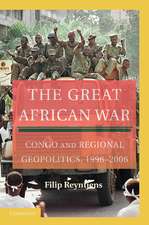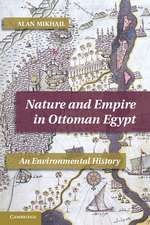The Animal in Ottoman Egypt
Autor Alan Mikhailen Limba Engleză Paperback – 13 apr 2017
| Toate formatele și edițiile | Preț | Express |
|---|---|---|
| Paperback (1) | 255.54 lei 31-37 zile | |
| Oxford University Press – 13 apr 2017 | 255.54 lei 31-37 zile | |
| Hardback (1) | 505.72 lei 31-37 zile | |
| Oxford University Press – 9 ian 2014 | 505.72 lei 31-37 zile |
Preț: 255.54 lei
Preț vechi: 294.68 lei
-13% Nou
Puncte Express: 383
Preț estimativ în valută:
48.90€ • 50.87$ • 40.37£
48.90€ • 50.87$ • 40.37£
Carte tipărită la comandă
Livrare economică 04-10 aprilie
Preluare comenzi: 021 569.72.76
Specificații
ISBN-13: 9780190655228
ISBN-10: 0190655224
Pagini: 336
Dimensiuni: 155 x 231 x 23 mm
Greutate: 0.52 kg
Editura: Oxford University Press
Colecția OUP USA
Locul publicării:New York, United States
ISBN-10: 0190655224
Pagini: 336
Dimensiuni: 155 x 231 x 23 mm
Greutate: 0.52 kg
Editura: Oxford University Press
Colecția OUP USA
Locul publicării:New York, United States
Recenzii
The book is well researched and supported by copious archival and manuscript resources from Europe, North America, North Africa, and Asia.... Mikhail marshals abundant evidence to support his thesis about the dramatic changes in human-animal relationships wrought by modernization.
Camels, donkeys, dogs, and water buffalo have their histories too, and in this compact book Alan Mikhail deftly shows just how closely intertwined they, and the histories of other animals, were with the human history of Ottoman Egypt. Carefully researched, lavishly illustrated, and engagingly written, this book sets a high standard for the historical study of human-animal relations and opens new vistas on the history of Egypt.
In this deeply and imaginatively researched book, Alan Mikhail uses insights drawn from the new field of animal history to revisit major transitions in Egyptian history, including modernization, urbanization, and integration into global networks. Particularly striking is the way his argument encompasses both the material conditions of animal existence, such as labor and disease, and the more abstract impact of religion, law, and politics.
This is a fascinating book, which uses the diminishing presence of animals in various key locations to shed light on major social transformations in late 18th and early 19th century Egypt. Everything from climate and bacteria to foreign imperialists and their new technologies shaped the new Egypt that we see emerging in this book; each of these agents of change gets its due in Mikhail's intricate story.
Camels, donkeys, dogs, and water buffalo have their histories too, and in this compact book Alan Mikhail deftly shows just how closely intertwined they, and the histories of other animals, were with the human history of Ottoman Egypt. Carefully researched, lavishly illustrated, and engagingly written, this book sets a high standard for the historical study of human-animal relations and opens new vistas on the history of Egypt.
In this deeply and imaginatively researched book, Alan Mikhail uses insights drawn from the new field of animal history to revisit major transitions in Egyptian history, including modernization, urbanization, and integration into global networks. Particularly striking is the way his argument encompasses both the material conditions of animal existence, such as labor and disease, and the more abstract impact of religion, law, and politics.
This is a fascinating book, which uses the diminishing presence of animals in various key locations to shed light on major social transformations in late 18th and early 19th century Egypt. Everything from climate and bacteria to foreign imperialists and their new technologies shaped the new Egypt that we see emerging in this book; each of these agents of change gets its due in Mikhail's intricate story.
Notă biografică
Alan Mikhail is Professor of History at Yale University. He is the author of Nature and Empire in Ottoman Egypt: An Environmental History, which won the Roger Owen Book Award of the Middle East Studies Association, and editor of Water on Sand: Environmental Histories of the Middle East and North Africa.














